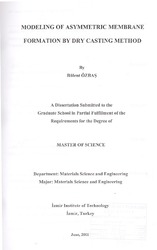Please use this identifier to cite or link to this item:
https://hdl.handle.net/11147/3868| Title: | Modelling of asymmetric membrane formation by dry casting method | Authors: | Özbaş, Bülent | Advisors: | Alsoy Altınkaya, Sacide | Publisher: | Izmir Institute of Technology | Abstract: | Many polymeric membranes are produced by phase inversion technique invented by Loeb and Sourirajan in 1962. One of the most challenging problems in membrane industry is to produce membranes with desirable structural characteristics which cause best performance for a specific application. The solution of this problem is facilitated by the development of mathematical models. The polymeric membrane formation process is a complicated process due to phase separation, simultaneous heat and mass transfer mechanisms controlled by complex thermodynamic and transport properties of polymer solutions. In this work, a fully predictive mathematical model developed by Alsoy (1998) was used to describe the mechanisms of membrane formation by dry casting method. Model equations consist of coupled unsteady state heat and mass transfer equations, film shrinkage as well as complex boundary conditions especially at polymer gas interface. A key component of the model is incorporation of multicomponent diffusion coefficients that consist of thermodynamic factors and self-diffusivities. The predictions from the model provide composition paths, temperature and thickness of the membrane. The beginning of phase transition was determined when compositions paths were plotted on the phase diagram. The model was applied to cellulose acetate/acetone/water system which is commonly used for asymmetric membrane formation. The model was used as a tool to optimize membrane formation process by investigating the effect of gas phase conditions, initial thickness and composition of the cast solution on the final membrane structure. The predictive ability of the model was evaluated by comparison with the data obtained from gravimetric measurements. Structural studies were conducted using scanning electron microscopy. Also, the permeability of prepared membranes to water vapor was measured using steady state technique. Both experimental and predicted results indicated that morphologies ranging from dense nonporous to asymmetric ones, in which a dense skin layer is supported by a porous layer, can be obtained with dry cast technique. | Description: | Thesis (Master)--Izmir Institute of Technology, Materials Science and Engineering, Izmir, 2001 Includes bibliographical references (leaves: 92-96) Text in English; Abstract: Turkish and English xii, 111 leaves |
URI: | http://hdl.handle.net/11147/3868 |
| Appears in Collections: | Master Degree / Yüksek Lisans Tezleri |
Files in This Item:
| File | Description | Size | Format | |
|---|---|---|---|---|
| T000027.PDF | MasterThesis | 34.58 MB | Adobe PDF |  View/Open |
CORE Recommender
Page view(s)
138
checked on Nov 18, 2024
Download(s)
24
checked on Nov 18, 2024
Google ScholarTM
Check
Items in GCRIS Repository are protected by copyright, with all rights reserved, unless otherwise indicated.